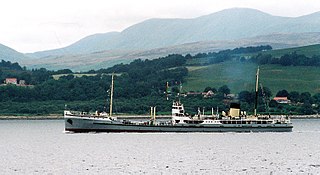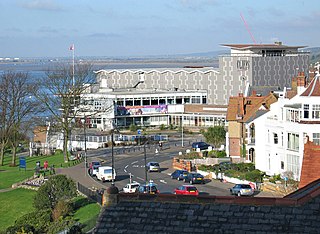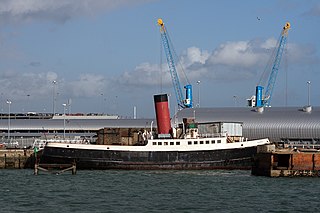
Southampton City Council is the local authority of the city of Southampton in the ceremonial county of Hampshire, England. Southampton has had a council since medieval times, which has been reformed on numerous occasions. Since 1997 the council has been a unitary authority, being a district council which also performs the functions of a county council; it is independent from Hampshire County Council.

SS Shieldhall is a preserved steamship that operates from Southampton. She is the largest operational historic steamship in Europe and one of the last reciprocating steam engined ships built, using technology that dated back to the last quarter of the 19th century and which was obsolete at the time of her construction. She spent her working life as one of the "Clyde sludge boats", making regular trips from Shieldhall in Glasgow, Scotland, down the River Clyde and Firth of Clyde past the Isle of Arran, to dump treated sewage sludge at sea. These steamships had a tradition, dating back to the First World War, of taking organised parties of passengers on their trips during the summer. SS Shieldhall has been preserved and offers cruises to the paying public.

Beecroft Art Gallery is an art gallery in Southend-on-Sea, Essex, England. The gallery is housed in the former municipal central library that opened in 1974 in the brutalist style as part of Southend Civic Centre. The Beecroft Art Gallery has a busy programme of changing exhibitions of art, photography and fashion. On the ground floor, the gallery presents temporary exhibitions of modern and contemporary artists, focusing on the work of emerging and established local artists. On the first floor, visitors can see works from the permanent collection and exciting fashion exhibitions. In the basement of the building is the charity The Jazz Centre UK.

Cliffs Pavilion is a theatre, sports, exhibition and concert venue located on Station Road in Westcliff-on-Sea, Essex, England, a suburb within the city of Southend-on-Sea. It is the largest purpose-built arts venue in Essex, and the largest capacity of any theatre in the East of England. In 2006, the operation of Cliffs Pavilion, along with the Palace Theatre, were handed to HQ Theatres by Southend-on-Sea Borough Council. HQ Theatres merged with Trafalgar Entertainment in 2021. In February 2022, the Cliffs played host to He Built This City concert, a tribute to the murdered MP for Southend West Sir David Amess.

The Civic Centre is a municipal building located in the Cultural Quarter area within the city of Southampton, England. It comprises offices occupied by Southampton City Council, the SeaCity Museum, the Guildhall, the Southampton City Art Gallery, and the city library. It was designed by the English architect Ernest Berry Webber in the Classical style in 1929 and constructed over a ten-year period. It was completed in 1939. Pevsner's Hampshire: South describes it as "the most ambitious civic building erected in the provinces in the interwar years". It was designated as a Grade II* listed building in 1980.

Ocean Village is a mixed-use marina, residential, business and leisure development on the mouth of the River Itchen in Southampton, on the south coast of England. Originally the site of Southampton's first working docks, the "Outer Dock" which opened in 1842, the area was redeveloped in 1986 and became the leisure marina it is today. After experiencing a period of stalled development with the late-2000s recession, Ocean Village underwent another series of major, multimillion-pound redevelopment projects. Current recreational facilities include a cinema, cafes, wine bars and restaurants.

Eliza Gladys Dean, known as Millvina Dean, was a British civil servant, cartographer, and the last living survivor of the sinking of the RMS Titanic on 15 April 1912. At two months old, she was also the youngest passenger aboard.

Southampton is a port city and unitary authority in Hampshire, England. It is located approximately 80 miles (130 km) southwest of London, 20 miles (32 km) west of Portsmouth, and 20 miles (32 km) southeast of Salisbury. Southampton had a population of 253,651 at the 2011 census, making it one of the most populous cities in southern England.
Southampton is a city in Hampshire, England. The area has been settled since the Stone Age. Its history has been affected by its geographical location, on a major estuary on the English Channel coast with an unusual double high tide, and by its proximity to Winchester and London; the ancient and modern capitals of England. Having been an important regional centre for centuries, Southampton was awarded city status by Queen Elizabeth II in 1964.

TitanicBelfast is a visitor attraction in Northern Ireland, which opened in 2012. A monument to Belfast's maritime heritage on the site of the former Harland & Wolff shipyard in the city's Titanic Quarter where the RMS Titanic was built. It tells the stories of the Titanic, which hit an iceberg and sank during her maiden voyage in 1912, and her sister ships RMS Olympic and HMHS Britannic. The building contains more than 12,000 square metres (130,000 sq ft) of floor space, most of which is occupied by a series of galleries, private function rooms and community facilities.

Solent Sky is an aviation museum in Southampton, England.

The Wool House is a medieval building in Southampton, Hampshire, England which was built to serve the wool trade. It has since had various uses.

Holyrood Church was one of the original five churches serving the old walled town of Southampton, England. Built in 1320, the church was destroyed by enemy bombing during the blitz in November 1940. In 1957 the shell of the church was dedicated as a memorial to the sailors of the Merchant Navy. It is a Grade II* listed building.

The Titanic Engineers' Memorial is a memorial in East (Andrews) Park, Southampton, United Kingdom, to the engineers who died in the Titanic disaster on 15 April 1912. The bronze and granite memorial was originally unveiled by Sir Archibald Denny, president of the Institute of Marine Engineers on 22 April 1914. The event was attended by an estimated 100,000 Southampton residents.

TSS T/T Calshot was a tug tender built in 1929 by John I Thornycroft & Co, and completed in 1930 for the Red Funnel Line. Calshot was one of only three surviving classical tender ships which served the great ocean liners, another example is the SS Nomadic, which tendered the ill-fated RMS Titanic on her maiden voyage at Cherbourg, France. The third being the Manchester Ship Canal's Daniel Adamson. In her career, Calshot has tendered some of the most famous ocean liners ever built, such as the RMS Caronia, the Cunard Queens RMS Queen Elizabeth and RMS Queen Mary, the SS United States, and the White Star Line ship RMS Olympic. During World War II she was requisitioned by the British Admiralty for servicing troop ships and took part in D-Day. She was a registered vessel of the National Historic Fleet of the United Kingdom, holding Certificate No. 1.
In total there are 317 listed buildings in the city of Southampton, of which 14 are Grade I, 20 are Grade II* and the remainder Grade II.

Memorials and monuments to victims of the sinking of the RMS Titanic exist in a number of places around the world associated with Titanic, notably in Belfast, Liverpool and Southampton in the United Kingdom; Halifax, Nova Scotia in Canada; and New York City and Washington, D.C. in the United States. The largest single contingent of victims came from Southampton, the home of most of the crew, which consequently has the greatest number of memorials. Titanic was built in Belfast, Northern Ireland, and had a "guarantee party" of engineers from shipbuilders Harland and Wolff aboard all of whom were lost in the disaster and are commemorated by a prominent memorial in the city. Other contingents of engineers aboard the ship came from the maritime cities of Liverpool in England and Glasgow in Scotland, which erected their own memorials. Several prominent victims, such as Titanic's captain, were commemorated individually. Elsewhere, in the United States and Australia, public memorials were erected to commemorate all the victims.

God's House Tower is a late 13th century gatehouse into the old town of Southampton, England. It stands at the south-east corner of the town walls and permitted access to the town from the Platform and Town Quay. It is now an arts and heritage venue, and has previously served as the town gaol and housed the Museum of Archaeology. The building is Grade I listed and a scheduled ancient monument.
The ocean liner Titanic has been extensively portrayed in films, books, memorials and museums.
Staplewood Campus in Marchwood, Hampshire is the training ground of Southampton Football Club. It was the home ground of Road-Sea Southampton until 1987 before being purchased by Southampton. The training campus houses the men's and women's first team alongside the academy sides.



















